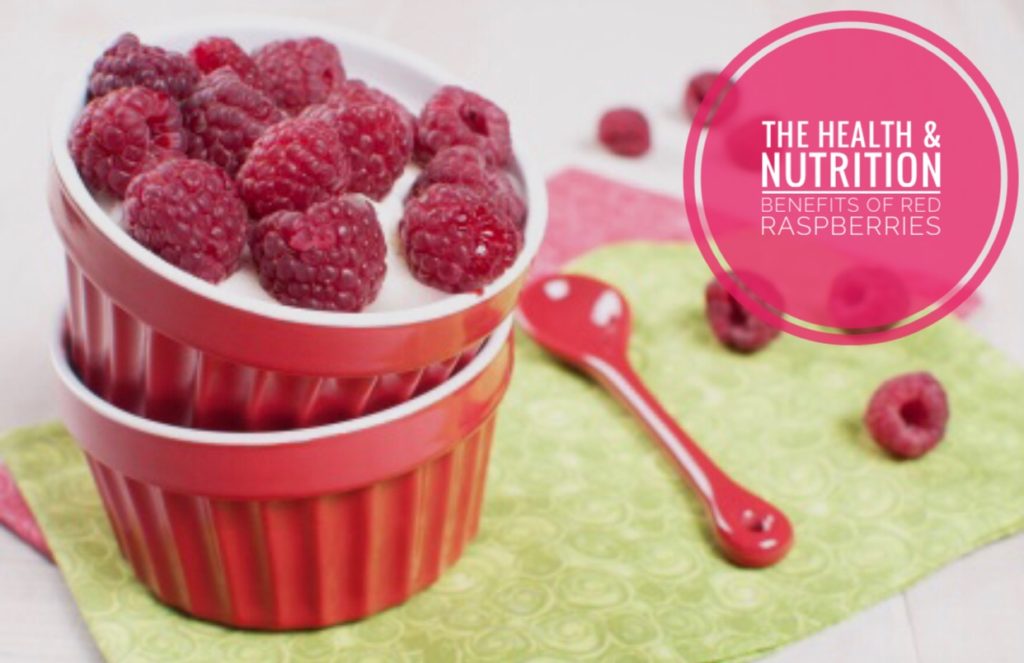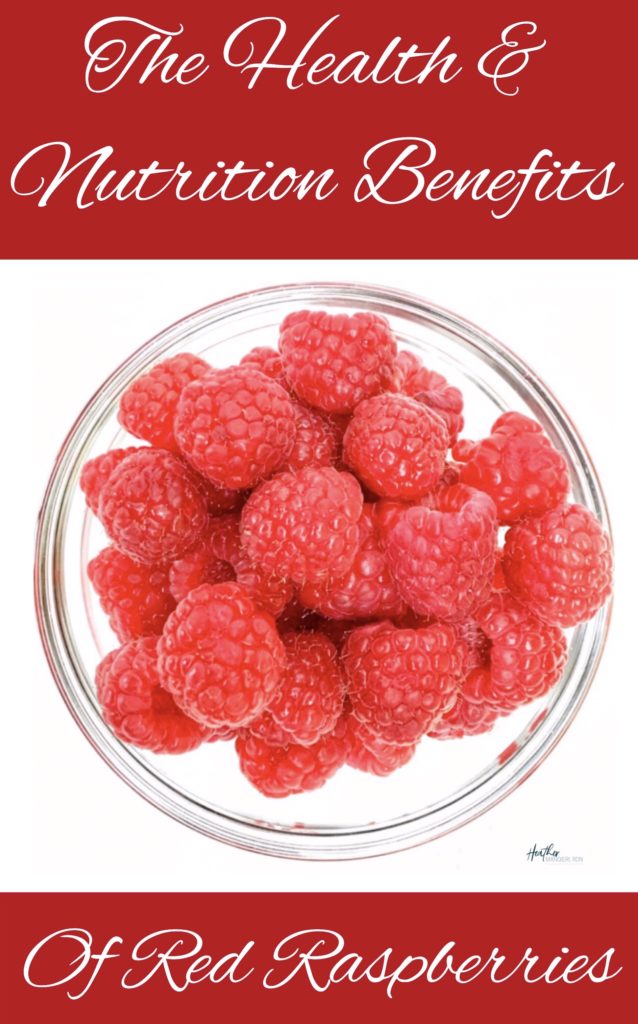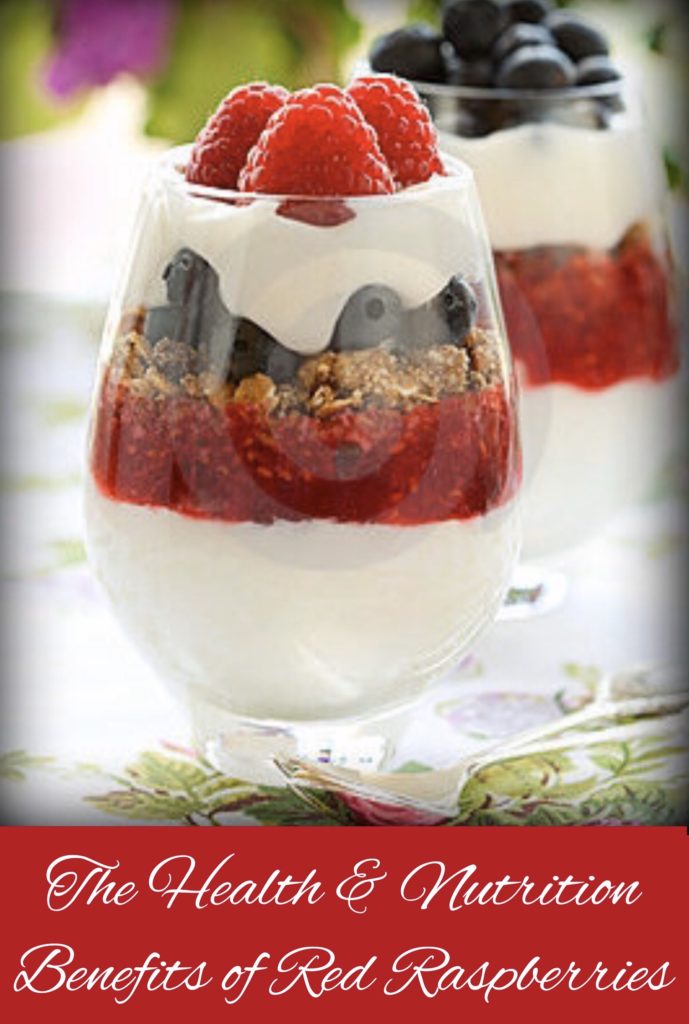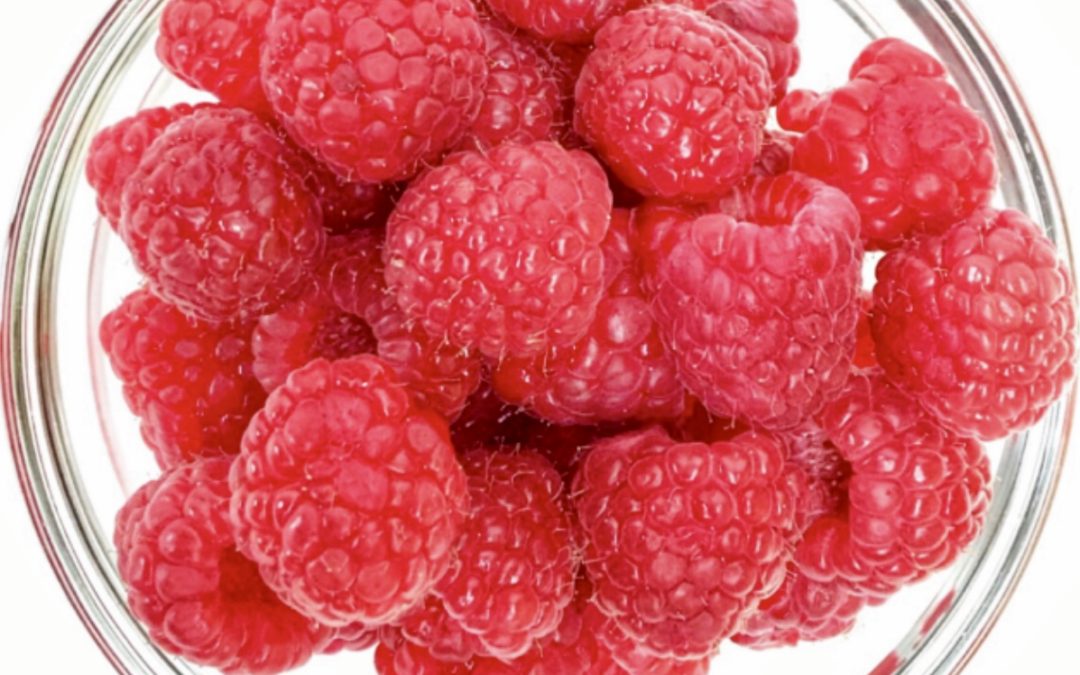Red Raspberries are a tart fruit that can be enjoyed alone or in combination with other foods. Learn the health and nutrition benefits they have to offer, plus how to select, store and enjoy them.

Athletes have heard me touting the benefits of foods naturally colored red for years. Today, I’m sharing information about one of my favorites. These fragile berries not only taste good, they’re good for you. I’m talking all about red raspberry fruits.
In case you missed it above, I purposely spelled out the word ‘fruit”. Red raspberry, scientifically known as Rubus idaeus, actually describes the entire plant. The fruit (red raspberry fruit) and leaves (red raspberry) have been used for medicinal purposes for centuries to treat a variety of ailments, including GI disorders, upper and lower respiratory tract infections, flu, diarrhea, among many others. Red raspberry leaf has even been used topically to treat inflammation of the mouth and throat and skin rashes. Today, however we’re focusing on the fruit you find at your local grocer or farmer’s market. The fruit that not only has loads of health benefits, it tastes good, too.

Health Benefits
Like other berries, red raspberries are a source of several compounds that contribute to good health. In addition to being high in antioxidants, they contain phytochemicals thought to have health benefits. The vitamins, minerals and compounds found in red raspberries have been shown to:
- Protect against free radical induced cell damage & reduce oxidative stress
- Preliminary research shows that ellagic acid (a phytochemical found in red raspberries) may play a role in the prevention or slowing the growth of cancer cells (in vitro and in animal studies only)
- Reduce the risk of cardiovascular disease
- Protect against infectious bacterial and viral diseases
- Preliminary research suggests that red raspberries may have anti-inflammatory effects
Nutrition Benefits
Vitamins, minerals, antioxidants and phytochemicals work together to support your health. Some focus on repairing oxidative stress, while others work to protecting against chronic conditions. Fiber is one example. Raspberries are one of the highest fiber berries. Just one cup provides over 25% of your daily needs. All that fiber not only promotes good digestive health, it may play a role in cancer prevention, heart health and brain health, too. And, it can be beneficial in weight management by helping you feel full longer and sooner.
Specifically, berries are
- Low in Calories- ~64 calories per cup
- High in fiber- 8 grams fiber per cup
- High in vitamin C- (~50% daily needs)
- Very high in polyphenols, including anthocyanins
- A major source of ellagic acid

Where Do Red Raspberries Come From?
If you’re buying red raspberries that are grown in the United States, there’s a good chance their coming from the west coast. The growing season of red raspberries is very short so the majority of the berries will be processed as Individual Quick Frozen (IQF) berries. What does that mean? It simply means they were picked at the peak ripeness and then frozen within hours of harvest. This process assures that the berry not only preserves the flavor and texture that it has at its peak but that it also retains its nutritional quality. Buying frozen is a convenient and cost effective way to enjoy red raspberries.
Caring for Red Raspberries
- When you get home, refrigerate berries immediately. If possible, store in the original container. Remove any damaged or moldy berries that you see, but do not sort through berries. Red raspberries are very fragile and messing with them will damage them.
- Do not wash before storing but rather wait until you are ready to use them. When you are ready to wash, place them in a colander and submerge a few times in a sink full of cold water. Drain well.
- For best quality, use or process berries within 1-2 days.
Ways to Enjoy Red Raspberries
Fresh or frozen, this berry tastes great. Here are some simple ways to enjoy the taste and health benefits of berries:
- Top cereal, oatmeal or yogurt with a handful of fresh or frozen red raspberries (Frozen berries, right out of the bag in their frozen state, work best when used on hot cereals. If you are using frozen berries on cold cereals, or yogurt let them stand a few minutes at room temperature)
- Scatter over salads to add a touch of sweetness
- Make a fruit smoothie with fresh or frozen berries
- Boost the nutrition in your sweet treat by adding red raspberries to muffins, cakes or brownies
- Make raspberry waffles or pancakes or puree red raspberries as a glaze in place of syrup
- Use red raspberries in your Memorial Day picnic dessert or dish
- Eat them plain
Do you have a favorite way to enjoy red raspberries?


 Hi, I’m Heather – a registered dietitian, busy mom, consultant, adventure junkie and travel addict who has mastered living healthy on the go. My blog is where I share simple recipes and healthy living tips to help and inspire others to live their best life.
Hi, I’m Heather – a registered dietitian, busy mom, consultant, adventure junkie and travel addict who has mastered living healthy on the go. My blog is where I share simple recipes and healthy living tips to help and inspire others to live their best life.
My parents have tons of rersbarpy bushes in their backyard, and I love going over and picking fresh berries to snack on. We brought a bunch to our place for our little party this past weekend too. They are absolutely the best, and one day when B and I have a larger yard I plan to plant our own! 🙂 Enjoy!!!
How many red raspberrys should u eat in a day.,or is there to much to eat in a day ??
Aiming for 1.5- 2 cups of fruit a day (and 2-3 cups of vegetables a day) is what’s recommended in a healthy eating pattern. The key to feeling best is to eat a variety. One cup of red raspberries provides 8 grams of fiber, which is considered an excellent source. So, if you get your two cups of fruit from raspberries, that means you get 16 grams of fiber from the fruit alone. While that should be ok, everyone is different. Eating too much fruit at one sitting, or in a day, may cause your stomach to get upset and could even cause other gastrointestinal distress. Just monitor your intake and how you feel. If you’re going to eat fruit, though, red raspberries are a great one to eat!